Artificial and Natural Water Bodies Change in China, 2000–2020
Abstract
:1. Introduction
2. Materials and Methods
2.1. Study Area
2.2. Data Sources
- (1)
- Surface water remote sensing monitoring data. The surface water data are derived from the monthly surface water distribution data set (2000–2020) extracted from Landsat TM/ETM+/OLI imagery by our research team [44]. The European Commission’s Joint Research Centre (JRC) global water surface distribution data (JRC Yearly Water Classification History, v1.3) from Google Earth Engine (GEE) was used for comparative validation.
- (2)
- Sample data for artificial water body distribution. Based on GF-1/6, sentinel-2 and Landsat TM/ETM+/OLI images taken in 2019 and 2020, 45,585 artificial water body location points were manually annotated by visual interpretation.
- (3)
- Dam latitude and longitude coordinate data. These mainly include China-IWRHR: dam location data provided by the China Institute of Water Resources and Hydropower Research; China-LDRL: the China Open Data Set on Large Dams, Reservoirs and Lakes developed and freely shared by Wang et al. [39]; GRanD v1.3: the Global Reservoir and Dam Database curated and hosted by Global Dam Watch [45]; and AQUASTAT: a global georeferenced database of dams collected by the Food and Agriculture Organization of the United Nations (FAO) global information system on water resources and agricultural water management [46].
2.3. Methodology
- (1)
- Synthesis of annual water surface data sets
- (2)
- Classification of artificial and natural water bodies
- (3)
- Construction of artificial and natural water body change indicators
- (4)
- Spatial and temporal variation characteristics and causes of artificial and natural water bodies
3. Results
3.1. Accuracy Evaluation
3.1.1. Accuracy Evaluation of Surface Water Data Sets
3.1.2. Accuracy Verification of Artificial Water Body Data Set
3.2. Spatial and Temporal Evolution of Artificial and Natural Water Bodies
3.3. Changes in the Geometric Center of Gravity of Artificial Water Bodies
4. Discussion
4.1. Reasons for Changes in the Center of Gravity of the Distribution of Artificial Water Bodies in Typical Basins
4.2. The Impact of Small and Medium-Sized Water Projects on Changes in the Distribution of Artificial Water Bodies
4.3. Outlooks, Implications and Limitations
5. Conclusions
Supplementary Materials
Author Contributions
Funding
Institutional Review Board Statement
Informed Consent Statement
Data Availability Statement
Acknowledgments
Conflicts of Interest
References
- Tulbure, M.G.; Broich, M.; Stehman, S.V.; Kommareddy, A. Surface water extent dynamics from three decades of seasonally continuous Landsat time series at subcontinental scale in a semi-arid region. Remote Sens. Environ. 2016, 178, 142–157. [Google Scholar] [CrossRef]
- Ferguson, I.M.; Maxwell, R.M. Human impacts on terrestrial hydrology: Climate change versus pumping and irrigation. Environ. Res. Lett. 2012, 7, 044022. [Google Scholar] [CrossRef] [Green Version]
- Pekel, J.F.; Cottam, A.; Gorelick, N.; Belward, A.S. High-resolution mapping of globasurface water and its long-term changes. Nature 2016, 540, 418–422. [Google Scholar] [CrossRef] [PubMed]
- United Nations Environment Programme. Progress on Freshwater Ecosystems: Tracking SDG 6 Series—Global Indicator 6.6.1 Updates and Acceleration Needs. 2021. Available online: https://www.unwater.org/publications/progress-on-water-related-ecosystems-661-2021-update/ (accessed on 20 April 2022).
- Hayes, N.M.; Deemer, B.R.; Corman, J.R.; Razavi, N.R.; Strock, K.E. Key differences between lakes and reservoirs modify climate signals: A case for a new conceptual model. Limnol. Oceanogr. Lett. 2017, 2, 47–62. [Google Scholar] [CrossRef]
- Xiang, Y.; Fu, Z.M.; Meng, Y.; Zhang, K.; Cheng, Z.F. Analysis of wave clipping effects of plain reservoir artificial islands based on MIKE21 SW model. Water Sci. Eng. 2019, 12, 179–187. [Google Scholar] [CrossRef]
- Mulligan, M.; van Soesbergen, A.; Sáenz, L. GOODD, a global dataset of more than 38,000 georeferenced dams. Sci. Data 2020, 7, 31. [Google Scholar] [CrossRef] [Green Version]
- Lehner, B.; Döll, P. Development and validation of a global database of lakes, reservoirs and wetlands. J. Hydrol. 2004, 296, 1–22. [Google Scholar] [CrossRef]
- Pokhrel, Y.; Burbano, M.; Roush, J.; Kang, H.; Sridhar, V.; Hyndman, D.W. A review of the integrated effects of changing climate, land use, and dams on Mekong river hydrology. Water 2018, 10, 266. [Google Scholar] [CrossRef] [Green Version]
- Kornijów, R. Controversies around dam reservoirs: Benefits, costs and future. Ecohydrol. Hydrobiol. 2009, 9, 141–148. [Google Scholar] [CrossRef]
- Antunes do Carmo, J.S.; de Carvalho, R.F. Large dam-reservoir systems: Guidelines and tools to estimate loads resulting from natural hazards. Nat. Hazards 2011, 59, 75–106. [Google Scholar] [CrossRef]
- Chen, Y.; Lin, P. The total risk analysis of large dams under flood hazards. Water 2018, 10, 140. [Google Scholar] [CrossRef] [Green Version]
- Zhang, Z.; Huang, Y.; Huang, J. Hydrologic alteration associated with dam construction in a medium-sized coastal watershed of southeast China. Water 2016, 8, 317. [Google Scholar] [CrossRef] [Green Version]
- Serpoush, B.; Khanian, M.; Shamsai, A. Hydropower plant site spotting using geographic information system and a MATLAB based algorithm. J. Clean. Prod. 2017, 152, 7–16. [Google Scholar] [CrossRef]
- Alhejji, A.; Kuriqi, A.; Jurasz, J.; Abo-Elyousr, F.K. Energy harvesting and water saving in arid regions via solar PV accommodation in irrigation canals. Energies 2021, 14, 2620. [Google Scholar] [CrossRef]
- Hennig, T.; Harlan, T. Shades of green energy: Geographies of small hydropower in Yunnan, China and the challenges of over-development. Glob. Environ. Change 2018, 49, 116–128. [Google Scholar] [CrossRef]
- Couto TB, A.; Olden, J.D. Global proliferation of small hydropower plants–science and policy. Front. Ecol. Environ. 2018, 16, 91–100. [Google Scholar] [CrossRef]
- Česonienė, L.; Dapkienė, M.; Punys, P. Assessment of the impact of small hydropower plants on the ecological status indicators of water bodies: A case study in Lithuania. Water 2021, 13, 433. [Google Scholar] [CrossRef]
- Lu, W.; Lei, H.; Yang, D.; Tang, L.; Miao, Q. Quantifying the impacts of small dam construction on hydrological alterations in the Jiulong River basin of Southeast China. J. Hydrol. 2018, 567, 382–392. [Google Scholar] [CrossRef]
- Kuriqi, A.; Pinheiro, A.N.; Sordo-Ward, A.; Garrote, L. Water-energy-ecosystem nexus: Balancing competing interests at a run-of-river hydropower plant coupling a hydrologic–ecohydraulic approach. Energy Convers. Manag. 2020, 223, 113267. [Google Scholar] [CrossRef]
- Kuriqi, A.; Pinheiro, A.N.; Sordo-Ward, A.; Bejarano, M.D.; Garrote, L. Ecological impacts of run-of-river hydropower plants—Current status and future prospects on the brink of energy transition. Renew. Sustain. Energy Rev. 2021, 142, 110833. [Google Scholar] [CrossRef]
- Wang, J.; Walter, B.A.; Yao, F.; Song, C.; Ding, M.; Maroof, A.S.; Zhu, J.; Fan, C.; McAlister, J.M.; Sikder, S.; et al. GeoDAR: Georeferenced global dam and reservoir dataset for bridging attributes and geolocations. Earth Syst. Sci. Data Discuss. 2022, 14, 1869–1899. [Google Scholar] [CrossRef]
- Liu, J.; Yang, W. Water sustainability for China and beyond. Science 2012, 337, 649–650. [Google Scholar] [CrossRef] [PubMed]
- Wang, X.; Xiao, X.; Zou, Z.; Dong, J.; Qin, Y.; Doughty, R.B.; Menarguez, M.A.; Chen, B.; Wang, J.; Ye, H.; et al. Gainers and losers of surface and terrestrial water resources in China during 1989–2016. Nat. Commun. 2020, 11, 3471. [Google Scholar]
- Tao, S.; Zhang, H.; Feng, Y.; Zhu, J.; Cai, Q.; Xiong, X.; Ma, S.; Fang, L.; Fang, W.; Tian, D.; et al. Changes in China’s water resources in the early 21st century. Front. Ecol. Environ. 2020, 18, 188–193. [Google Scholar] [CrossRef]
- Feng, S.; Liu, S.; Huang, Z.; Jing, L.; Zhao, M.; Peng, X.; Yan, W.; Wu, Y.; Lv, Y.; Smith, A.; et al. Inland water bodies in China: Features discovered in the long-term satellite data. Proc. Natl. Acad. Sci. USA 2019, 116, 25491–25496. [Google Scholar] [CrossRef] [PubMed] [Green Version]
- Zhou, F.; Bo, Y.; Ciais, P.; Dumas, P.; Tang, Q.; Wang, X.; Liu, J.; Zheng, C.; Polcher, J.; Yin, Z.; et al. Deceleration of China’s human water use and its key drivers. Proc. Natl. Acad. Sci. USA 2020, 117, 7702–7711. [Google Scholar] [CrossRef] [PubMed]
- Yang, X.; Lu, X. Drastic change in China’s lakes and reservoirs over the past decades. Sci. Rep. 2014, 4, 6041. [Google Scholar] [CrossRef] [Green Version]
- Chen, J.; Wang, J.; Guo, J.; Yu, J.; Zeng, Y.; Yang, H.; Zhang, R. Eco-environment of reservoirs in China: Characteristics and research prospects. Prog. Phys. Geogr. Earth Environ. 2018, 42, 185–201. [Google Scholar] [CrossRef]
- Tilt, B. Dams and Development in China; Columbia University Press: New York, NY, USA, 2014. [Google Scholar]
- Liu, X.; Tang, Q.; Voisin, N.; Cui, H. Projected impacts of climate change on hydropower potential in China. Hydrol. Earth Syst. Sci. 2016, 20, 3343–3359. [Google Scholar] [CrossRef] [Green Version]
- Micovic, Z.; Hartford, D.N.; Schaefer, M.G.; Barker, B.L. A non-traditional approach to the analysis of flood hazard for dams. Stoch. Environ. Res. Risk Assess. 2016, 30, 559–581. [Google Scholar] [CrossRef]
- Ho, M.; Lall, U.; Allaire, M.; Devineni, N.; Kwon, H.H.; Pal, I.; Raff, D.; Wegner, D. The future role of dams in the United States of America. Water Resour. Res. 2017, 53, 982–998. [Google Scholar] [CrossRef]
- Wang, J.; Chen, J.; Ding, S.; Guo, J.; Christopher, D.; Dai, Z.; Yang, H. Effects of seasonal hypoxia on the release of phosphorus from sediments in deep-water ecosystem: A case study in Hongfeng Reservoir, Southwest China. Environ. Pollut. 2016, 219, 858–865. [Google Scholar] [CrossRef] [PubMed]
- Song, J.; Sciubba, M.; Kam, J. Risk and impact assessment of dams in the contiguous United States using the 2018 National Inventory of dams database. Water 2021, 13, 1066. [Google Scholar] [CrossRef]
- Li, Y.; Niu, Z.; Xu, Z.; Yan, X. Construction of high spatial-temporal water body dataset in China based on Sentinel-1 archives and GEE. Remote Sens. 2020, 12, 2413. [Google Scholar] [CrossRef]
- Paredes-Beltran, B.; Sordo-Ward, A.; Garrote, L. Dataset of Georeferenced Dams in South America (DDSA). Earth Syst. Sci. Data 2021, 13, 213–229. [Google Scholar] [CrossRef]
- Li, Y.; Niu, Z. Systematic method for mapping fine-resolution water cover types in China based on time series Sentinel-1 and 2 images. Int. J. Appl. Earth Obs. Geoinf. 2022, 106, 102656. [Google Scholar] [CrossRef]
- Wang, X.; Xiao, X.; Qin, Y.; Dong, J.; Wu, J.; Li, B. Improved maps of surface water bodies, large dams, reservoirs, and lakes in China. Earth Syst. Sci. Data Discuss. 2022, in press. [Google Scholar]
- Jin, H.; Chen, X.; Wang, Y.; Zhong, R.; Zhao, T.; Liu, Z.; Tu, X. Spatio-temporal distribution of NDVI and its influencing factors in China. J. Hy-Drology 2021, 603, 127129. [Google Scholar] [CrossRef]
- Xiong, J.; Wang, Z.; Lai, C.; Liao, Y.; Wu, X. Spatiotemporal variability of sunshine duration and influential climatic factors in mainland China during 1959–2017. Int. J. Climatol. 2020, 40, 6282–6300. [Google Scholar] [CrossRef]
- Liu, J.; Zang, C.; Tian, S.; Liu, J.; Yang, H.; Jia, S.; You, L.; Liu, B.; Zhang, M. Water conservancy projects in China: Achievements, challenges and way forward. Glob. Environ. Change 2013, 23, 633–643. [Google Scholar] [CrossRef] [Green Version]
- Zhang, Z.; Chen, X.; Xu, C.Y.; Yuan, L.; Yong, B.; Yan, S. Evaluating the non-stationary relationship between precipitation and streamflow in nine major basins of China during the past 50 years. J. Hydrol. 2011, 409, 81–93. [Google Scholar] [CrossRef]
- Tang, H.; Lu, S.; Ali Baig, M.H.; Li, M.; Fang, C.; Wang, Y. Large-Scale Surface Water Mapping Based on Landsat and Sentinel-1 Images. Water 2022, 14, 1454. [Google Scholar] [CrossRef]
- Lehner, B.; Liermann, C.R.; Revenga, C.; Vörösmarty, C.; Fekete, B.; Crouzet, P.; Döll, P.; Endejan, M.; Frenken, K.; Magome, J.; et al. High-resolution mapping of the world’s reservoirs and dams for sustainable river-flow management. Front. Ecol. Environ. 2011, 9, 494–502. [Google Scholar] [CrossRef] [Green Version]
- Rufin, P.; Levers, C.; Baumann, M.; Jägermeyr, J.; Krueger, T.; Kuemmerle, T.; Hostert, P. Global-scale patterns and determinants of cropping frequency in irrigation dam command areas. Glob. Environ. Change 2018, 50, 110–122. [Google Scholar] [CrossRef]
- Duan, Y.; Tian, B.; Li, X.; Liu, D.; Sengupta, D.; Wang, Y.; Peng, Y. Tracking changes in aquaculture ponds on the China coast using 30 years of Landsat images. Int. J. Appl. Earth Obs. Geoinf. 2021, 102, 102383. [Google Scholar] [CrossRef]
- Chin, A.; Laurencio, L.R.; Martinez, A.E. The hydrologic importance of small-and medium-sized dams: Examples from Texas. Prof. Geogr. 2008, 60, 238–251. [Google Scholar] [CrossRef]
- Ayalew, T.B.; Krajewski, W.F.; Mantilla, R.; Wright, D.B.; Small, S.J. Effect of spatially distributed small dams on flood frequency: Insights from the soap creek watershed. J. Hydrol. Eng. 2017, 22, 04017011. [Google Scholar] [CrossRef]
- Messager, M.L.; Lehner, B.; Grill, G.; Nedeva, I.; Schmitt, O. Estimating the volume and age of water stored in global lakes using a geo-statistical approach. Nat. Commun. 2016, 7, 13603. [Google Scholar] [CrossRef]
- Bulletin of First National Census for Water. Available online: http://slpc.mwr.gov.cn/gbzq/ (accessed on 28 April 2022).
- Graf, W.L. Geomorphology and American dams: The scientific, social, and economic context. Geomorphology 2005, 71, 3–26. [Google Scholar] [CrossRef]
- Zhao, Q.; Liu, S.; Deng, L.; Dong, S.; Yang, Z.; Yang, J. Landscape change and hydrologic alteration associated with dam construction. International J. Appl. Earth Obs. Geoinf. 2012, 16, 17–26. [Google Scholar] [CrossRef]
- Costigan, K.H.; Daniels, M.D. Damming the prairie: Human alteration of Great Plains river regimes. J. Hydrol. 2012, 444, 90–99. [Google Scholar] [CrossRef]
- McManamay, R.A.; Orth, D.J.; Dolloff, C.A. Revisiting the homogenization of dammed rivers in the southeastern US. J. Hydrol. 2012, 424, 217–237. [Google Scholar] [CrossRef] [Green Version]
- Piégay, H.; Gregory, K.J.; Bondarev, V.; Chin, A.; Dahlstrom, N.; Elosegi, A.; Gregory, S.V.; Joshi, V.; Mutz, M.; Rinaldi, M.; et al. Public perception as a barrier to introducing wood in rivers for restoration purposes. Environ. Manag. 2005, 36, 665–674. [Google Scholar] [CrossRef] [PubMed]
- Ferreira, S.; Meunier, S.; Heinrich, M.; Cherni, J.A.; Darga, A.; Quéval, L. A decision support tool to place drinking water sources in rural communities. Sci. Total Environ. 2022, 833, 155069. [Google Scholar] [CrossRef]
- Magilligan, F.J.; Graber, B.E.; Nislow, K.H.; Chipman, J.W.; Sneddon, C.S.; Fox, C.A. River restoration by dam removal: Enhancing connectivity at watershed scalesRiver restoration by dam removal. Elem. Sci. Anthr. 2016, 4, 000108. [Google Scholar] [CrossRef] [Green Version]
- Jing, M.; Jie, Y.; Shou-yi, L.; Lu, W. Application of fuzzy analytic hierarchy process in the risk assessment of dangerous small-sized reservoirs. Int. J. Mach. Learn. Cybern. 2018, 9, 113–123. [Google Scholar] [CrossRef]
- Measuring Changes in Reservoir Surface Area. Available online: https://www.sdg661.app/productsmethods (accessed on 21 May 2022).
- Howard Coker, E.; Hotchkiss, R.H.; Johnson, D.A. Conversion of a Missouri River Dam and Reservoir to a Sustainable System: Sediment Management 1. JAWRA J. Am. Water Resour. Assoc. 2009, 45, 815–827. [Google Scholar] [CrossRef]
- Biggs, J.; Von Fumetti, S.; Kelly-Quinn, M. The importance of small waterbodies for biodiversity and ecosystem services: Implications for policy makers. Hydrobiologia 2017, 793, 3–39. [Google Scholar] [CrossRef]
- Cantonati, M.; Poikane, S.; Pringle, C.M.; Stevens, L.E.; Turak, E.; Heino, J.; Richardson, J.S.; Bolpagni, R.; Borrini, A.; Cid, N.; et al. Characteristics, main impacts, and stewardship of natural and artificial freshwater environments: Consequences for biodiversity conservation. Water 2020, 12, 260. [Google Scholar] [CrossRef] [Green Version]
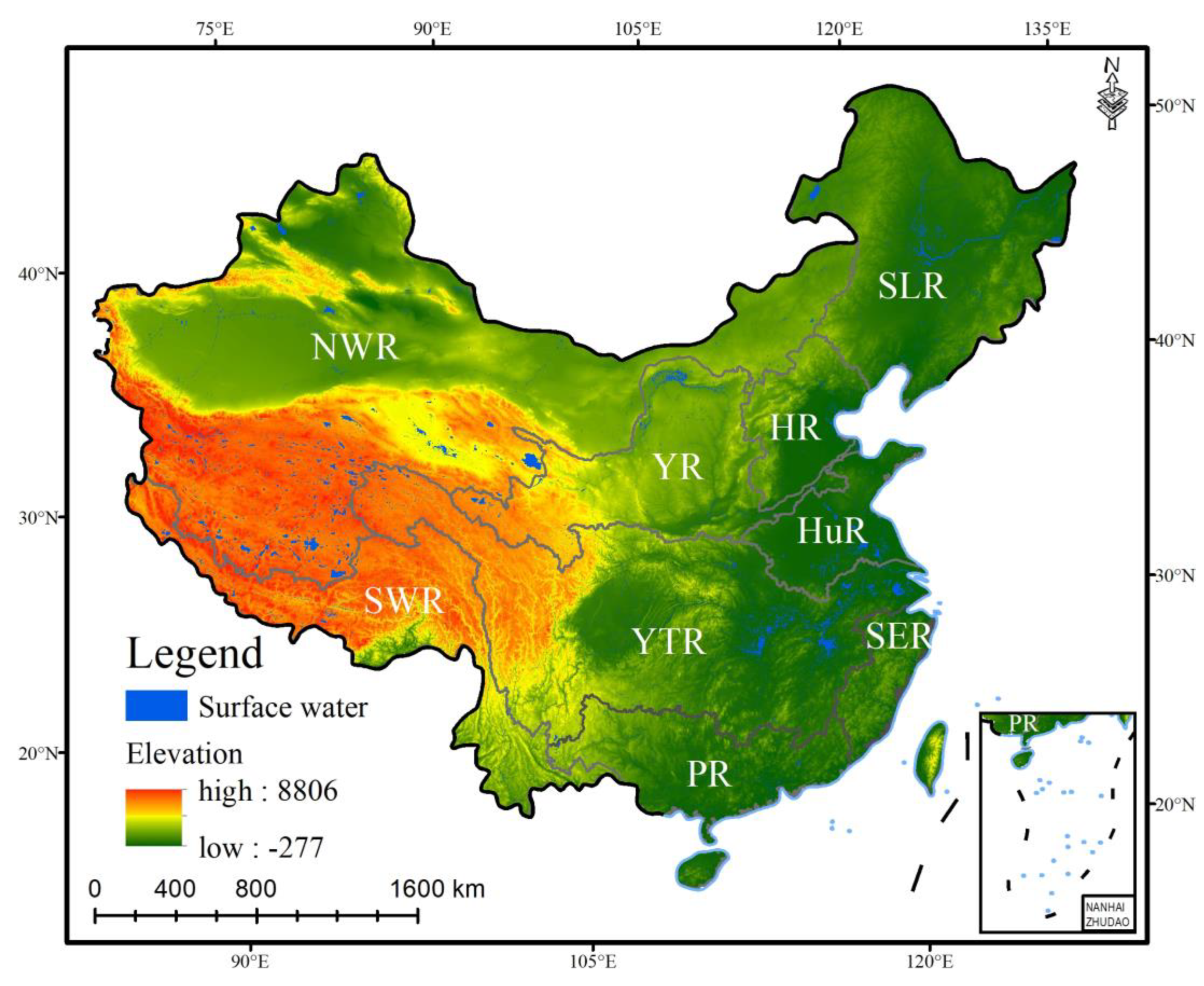

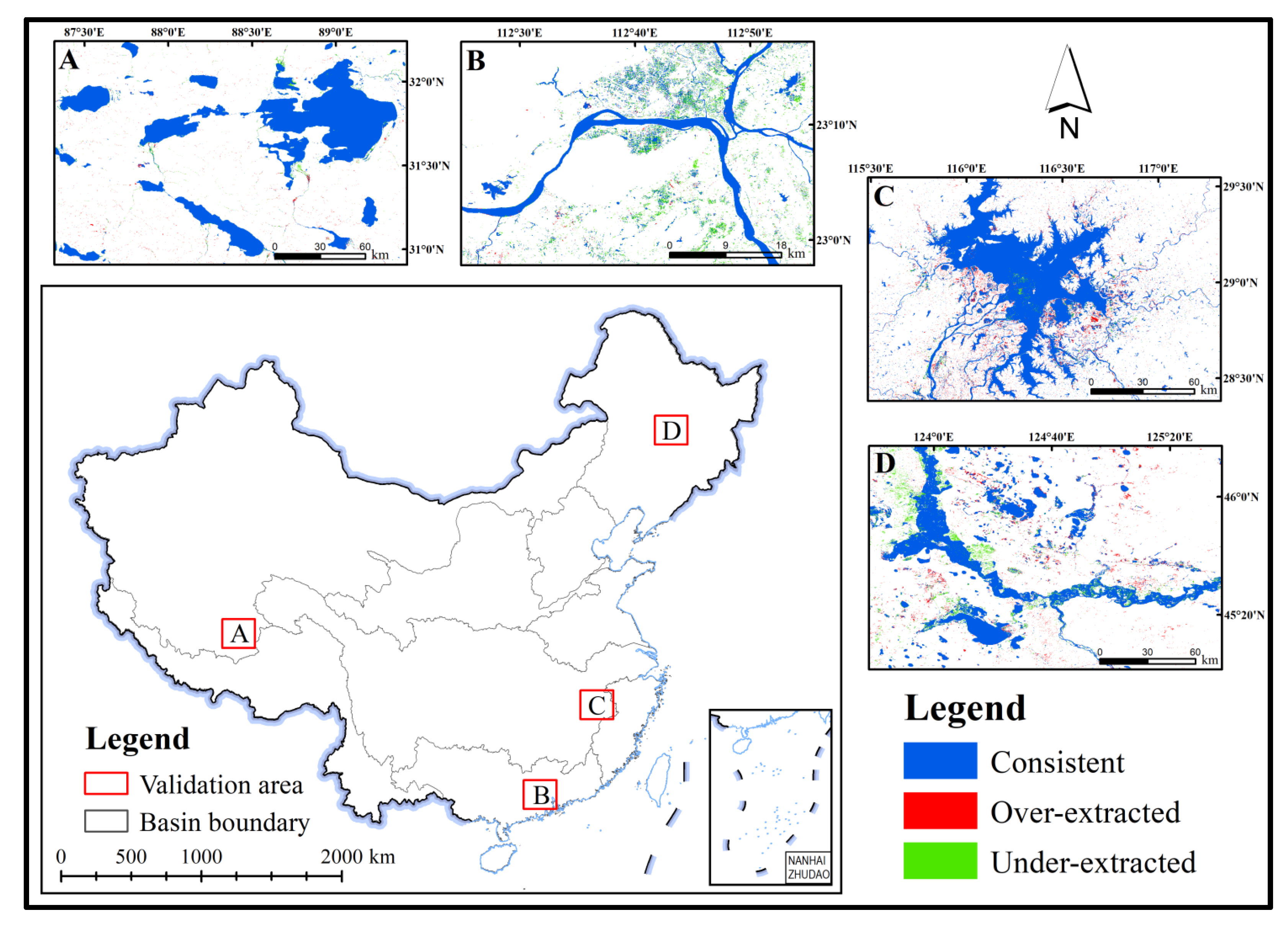

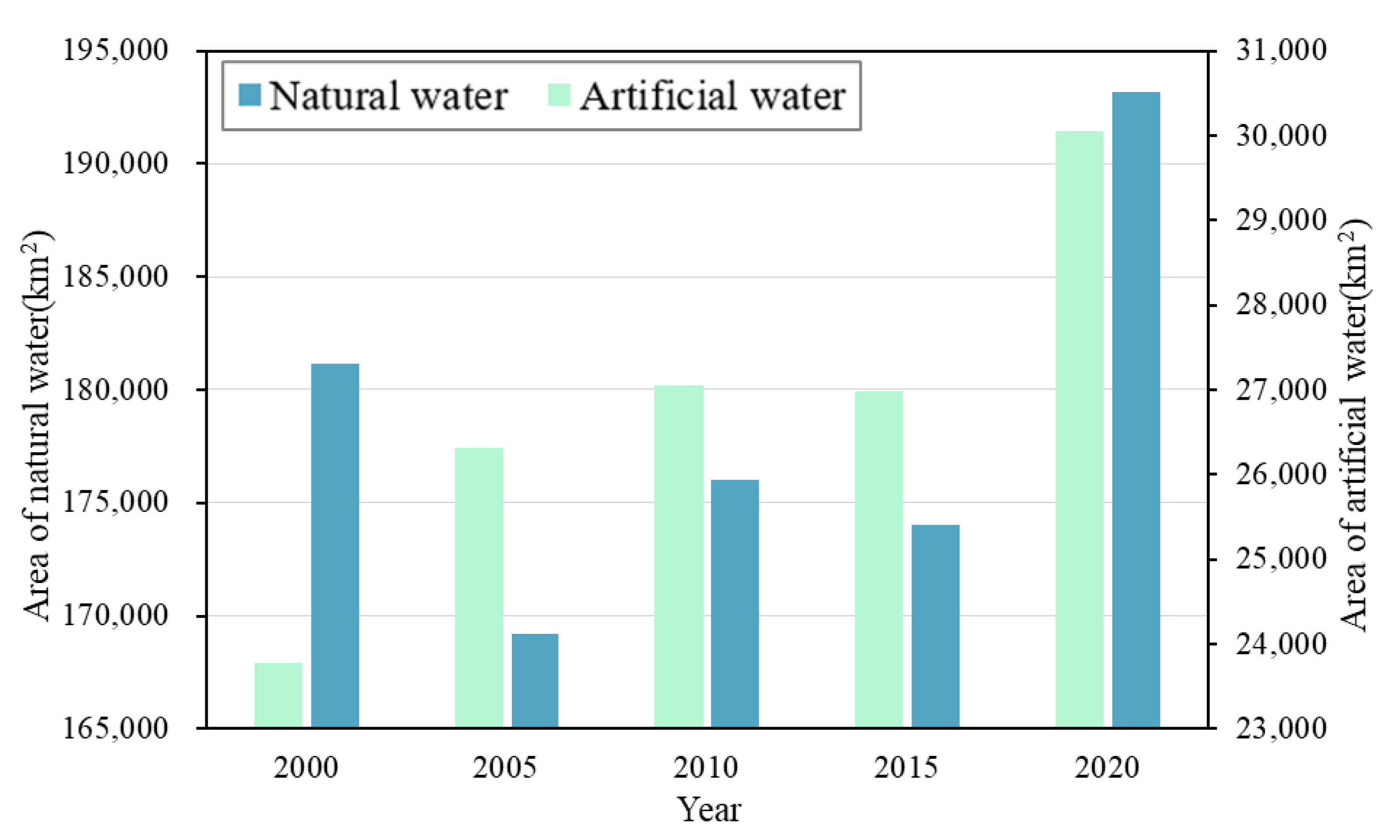
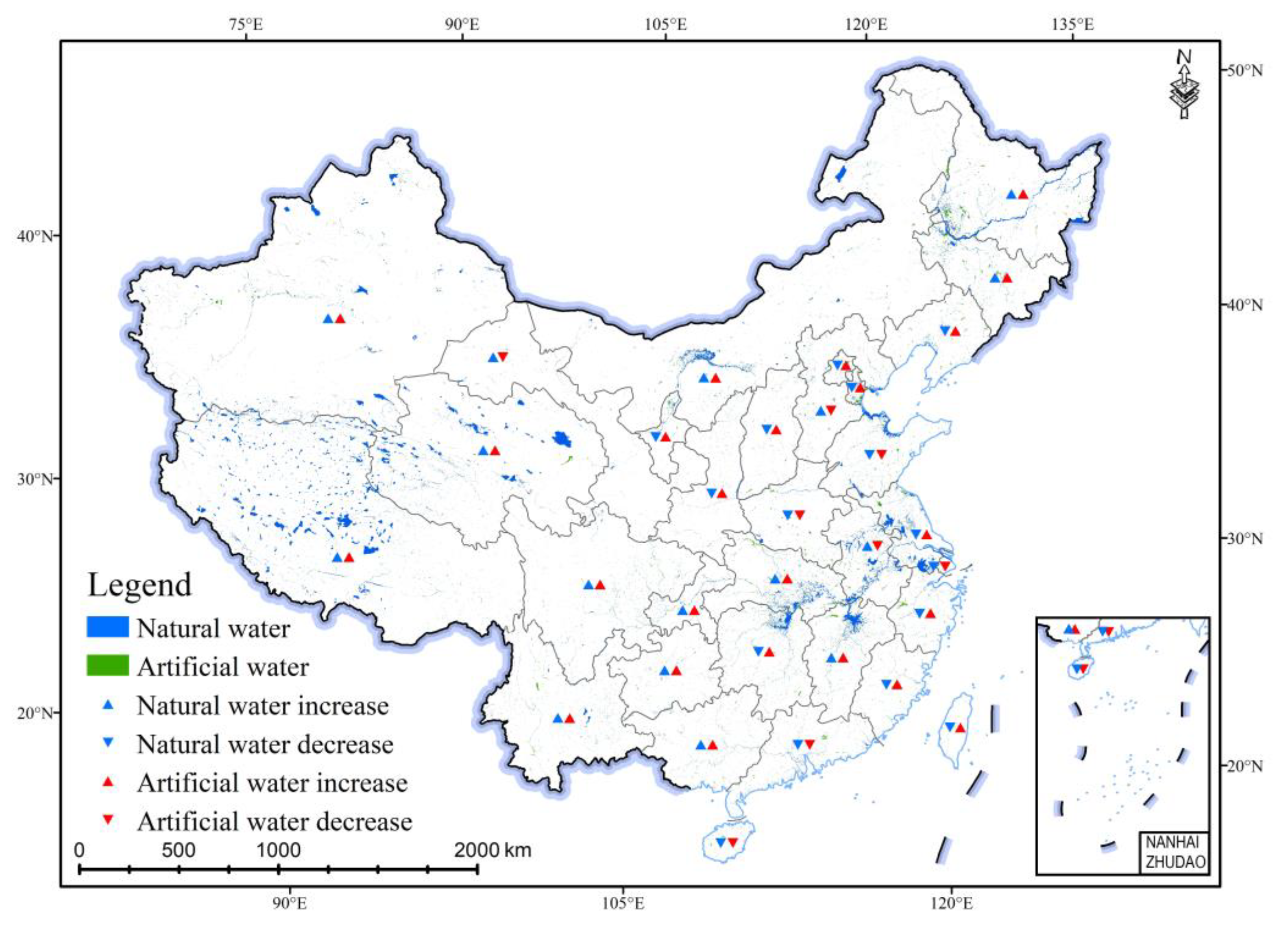
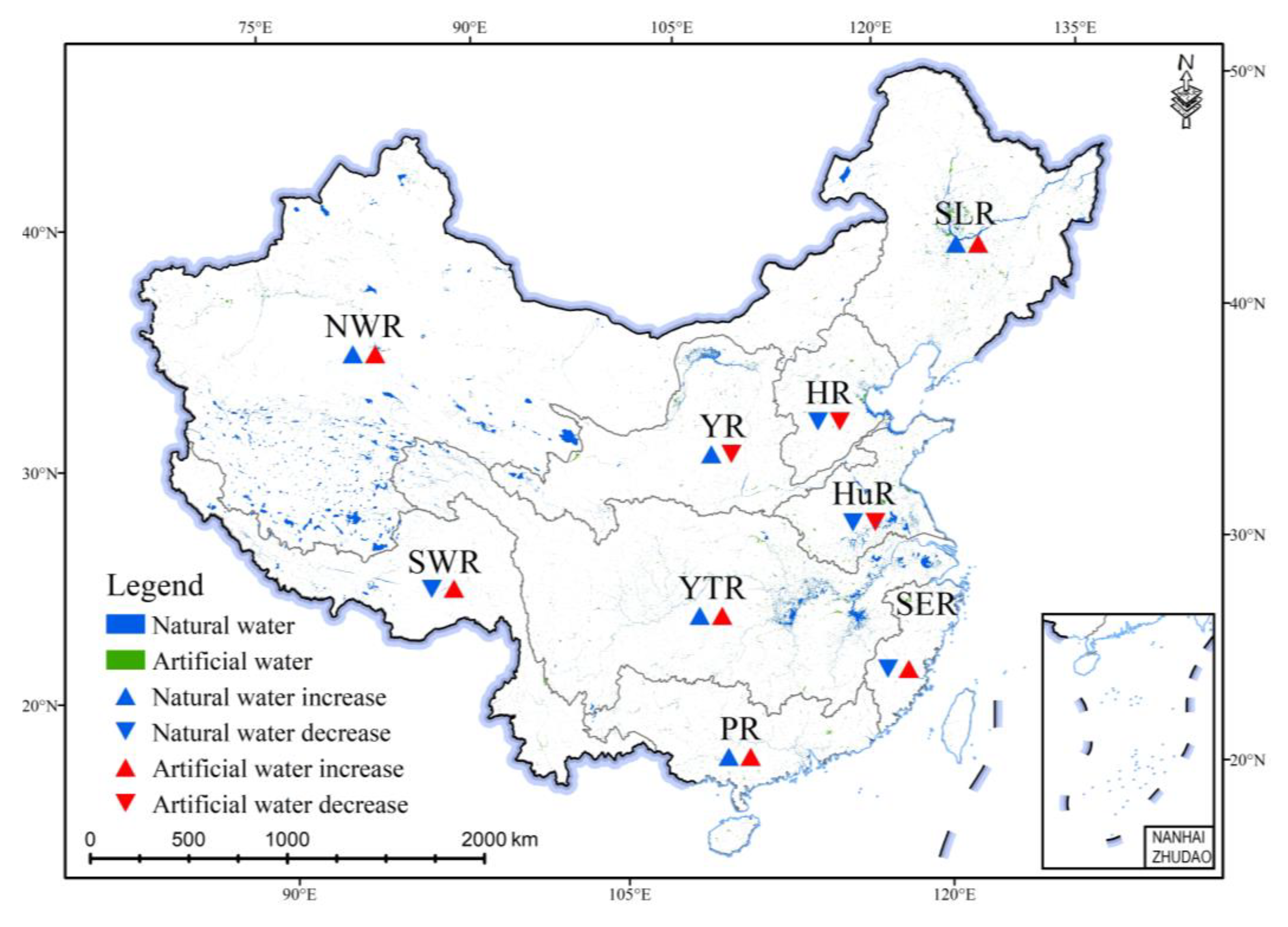

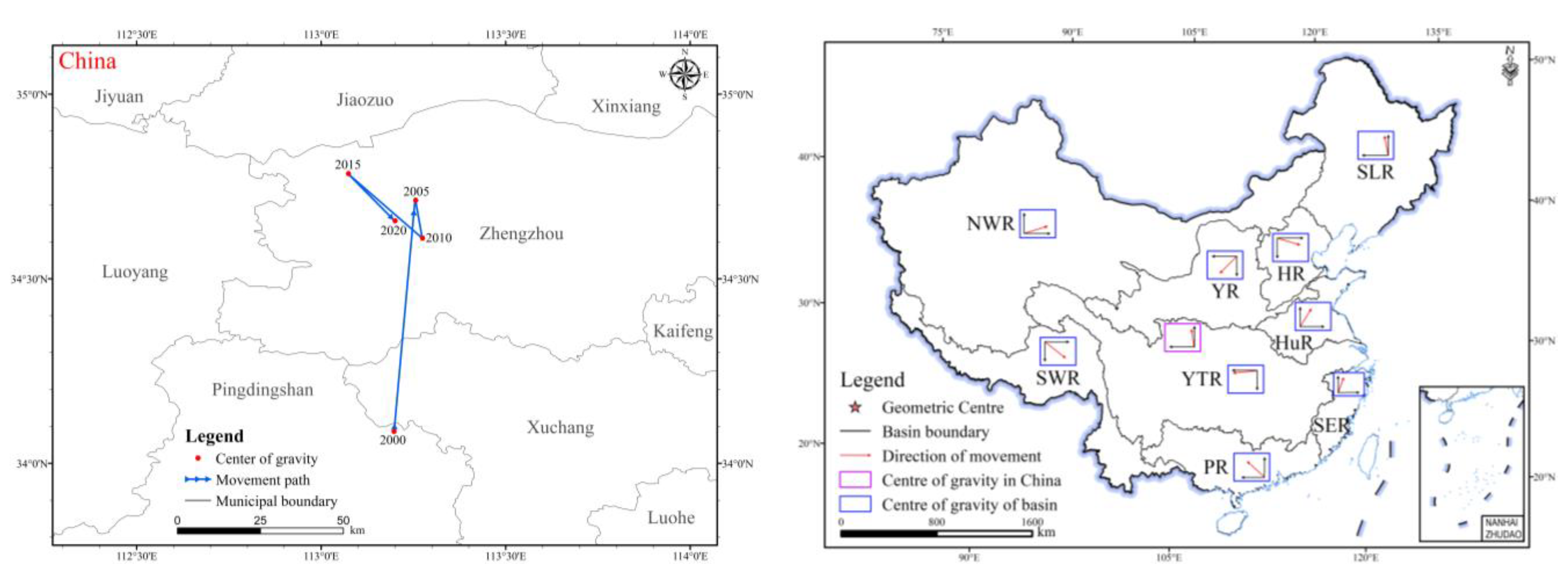
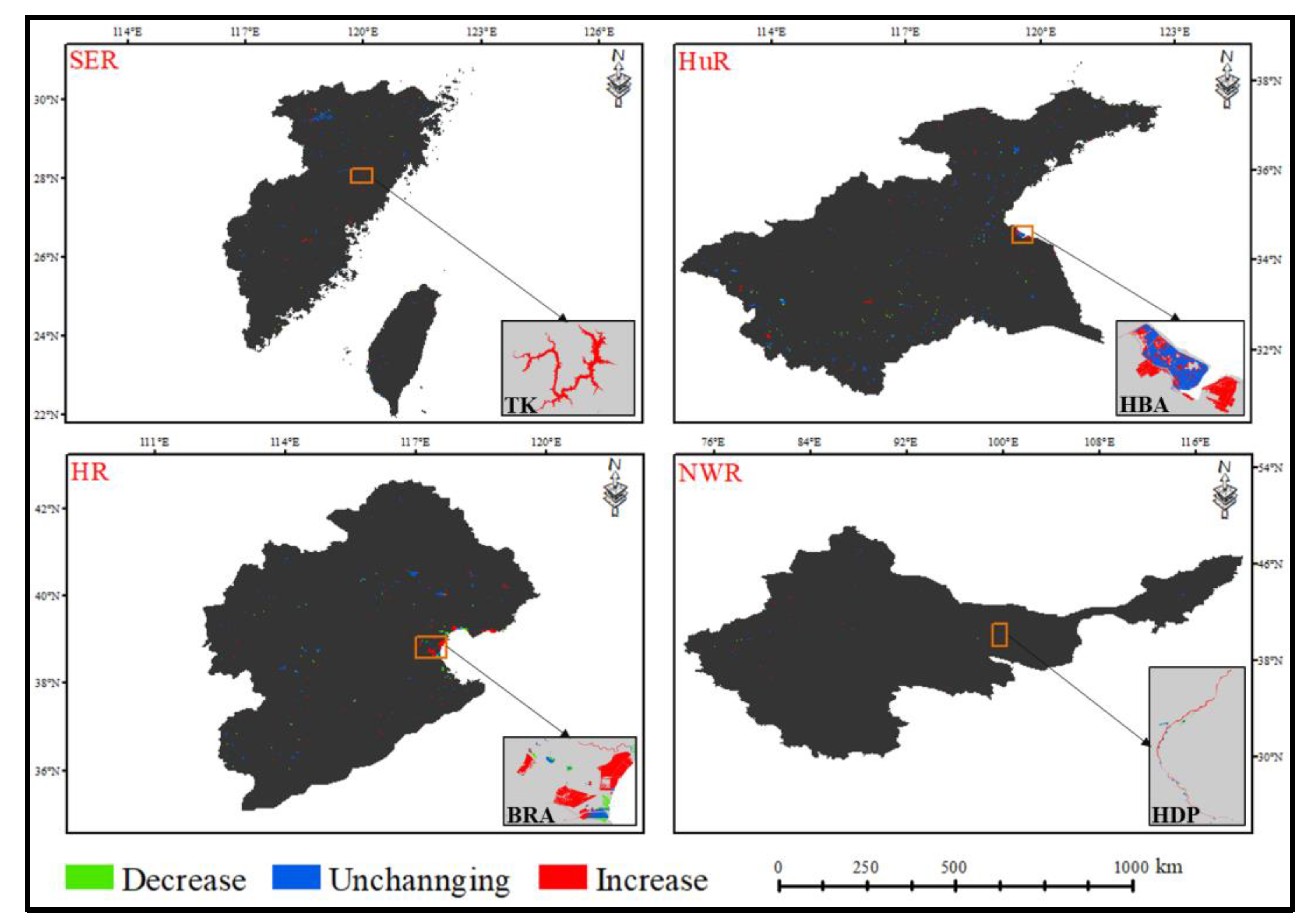
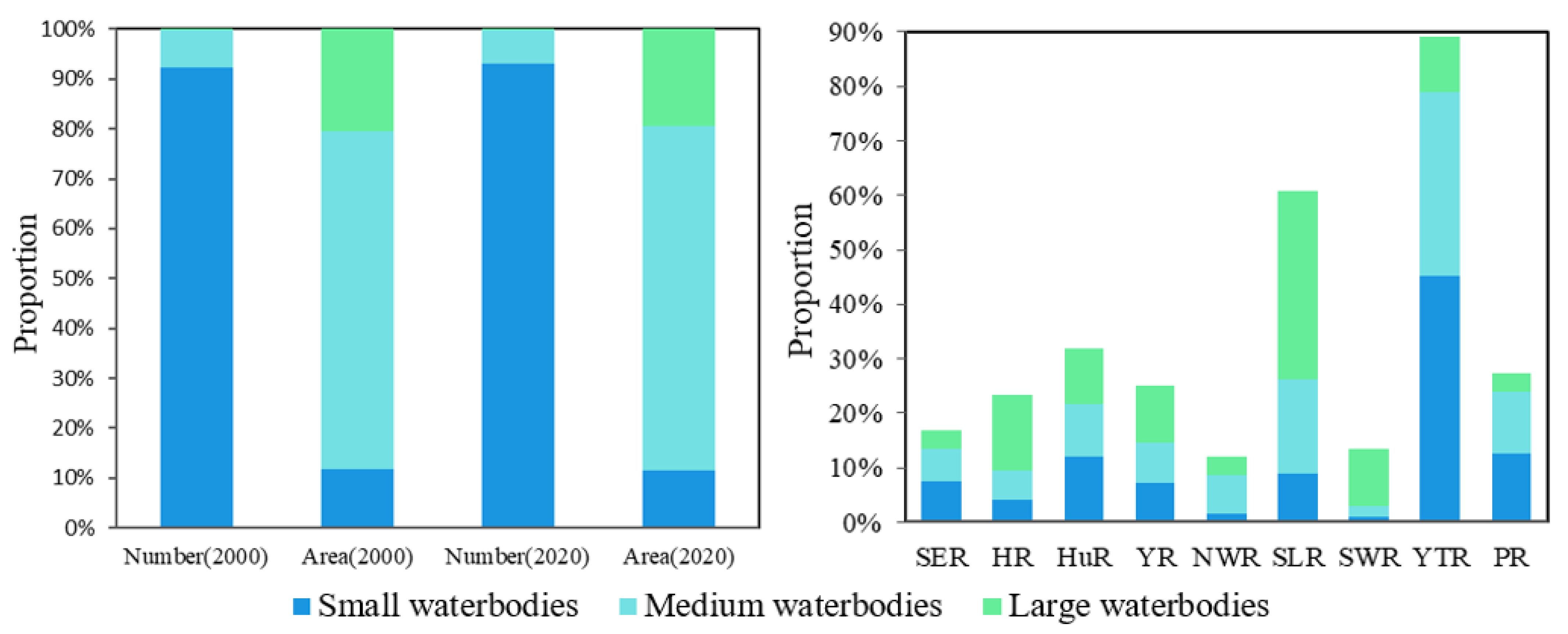
| Region | JRC (km2) | Consistent (km2) | Under-Extracted (km2) | Over-Extracted (km2) | Matching Rate (%) |
|---|---|---|---|---|---|
| A | 4686.81 | 4548.55 | 138.26 | 100.76 | 97.05 |
| B | 252.91 | 230.82 | 22.08 | 9.00 | 91.27 |
| C | 4431.94 | 4314.65 | 117.29 | 415.96 | 97.35 |
| D | 3174.11 | 2964.07 | 210.04 | 316.86 | 93.38 |
| Data Set | Total Dams | Dams in China | Matching Dams | Precision | Average Precision |
|---|---|---|---|---|---|
| China-IWRHR | 4662 | 4662 | 4200 | 90.1% | 89.5% |
| China-LDRL | 2140 | 2140 | 1830 | 85.5% | |
| GRanD v1.3 | 7320 | 921 | 831 | 90.2% | |
| AQUASTAT | 14,500 | 722 | 666 | 92.2% |
| MK Test Parameters | Artificial Water | Natural Water |
|---|---|---|
| Kendall’s tau | 0.800 | 0.200 |
| p-value | 0.086 | 0.806 |
| Alpha(α) | 0.10 | 0.10 |
| H0 | Reject | Accept |
| MK null hypothesis H0: There is no trend in the series. | ||
| Region | Type | (km2) | (km2) | |
|---|---|---|---|---|
| SER | Artificial | 1404.79 | 1586.99 | 13.0 |
| Natural | 2459.98 | 2411.52 | −2.0 | |
| HR | Artificial | 1757.57 | 1701.03 | −3.2 |
| Natural | 5684.63 | 5220.06 | −8.2 | |
| HuR | Artificial | 2459.65 | 2047.92 | −16.7 |
| Natural | 11,383.76 | 10,980.19 | −3.5 | |
| YR | Artificial | 2056.57 | 1901.43 | −7.5 |
| Natural | 13,259.74 | 14,751.92 | 11.3 | |
| NWR | Artificial | 2124.99 | 2409.33 | 13.4 |
| Natural | 58,971.60 | 65,569.37 | 11.2 | |
| SLR | Artificial | 5072.70 | 6370.03 | 25.6 |
| Natural | 20,320.17 | 20,726.47 | 2.0 | |
| SWR | Artificial | 416.11 | 859.98 | 106.7 |
| Natural | 9683.71 | 9222.60 | −4.8 | |
| YTR | Artificial | 7542.90 | 8023.30 | 6.4 |
| Natural | 40,234.77 | 41,831.63 | 4.0 | |
| PR | Artificial | 2758.85 | 2848.74 | 3.3 |
| Natural | 5882.33 | 6023.87 | 2.4 |
Publisher’s Note: MDPI stays neutral with regard to jurisdictional claims in published maps and institutional affiliations. |
© 2022 by the authors. Licensee MDPI, Basel, Switzerland. This article is an open access article distributed under the terms and conditions of the Creative Commons Attribution (CC BY) license (https://creativecommons.org/licenses/by/4.0/).
Share and Cite
Wang, Y.; Lu, S.; Zi, F.; Tang, H.; Li, M.; Li, X.; Fang, C.; Ikhumhen, H.O. Artificial and Natural Water Bodies Change in China, 2000–2020. Water 2022, 14, 1756. https://doi.org/10.3390/w14111756
Wang Y, Lu S, Zi F, Tang H, Li M, Li X, Fang C, Ikhumhen HO. Artificial and Natural Water Bodies Change in China, 2000–2020. Water. 2022; 14(11):1756. https://doi.org/10.3390/w14111756
Chicago/Turabian StyleWang, Yong, Shanlong Lu, Feng Zi, Hailong Tang, Mingyang Li, Xinru Li, Chun Fang, and Harrison Odion Ikhumhen. 2022. "Artificial and Natural Water Bodies Change in China, 2000–2020" Water 14, no. 11: 1756. https://doi.org/10.3390/w14111756
APA StyleWang, Y., Lu, S., Zi, F., Tang, H., Li, M., Li, X., Fang, C., & Ikhumhen, H. O. (2022). Artificial and Natural Water Bodies Change in China, 2000–2020. Water, 14(11), 1756. https://doi.org/10.3390/w14111756







